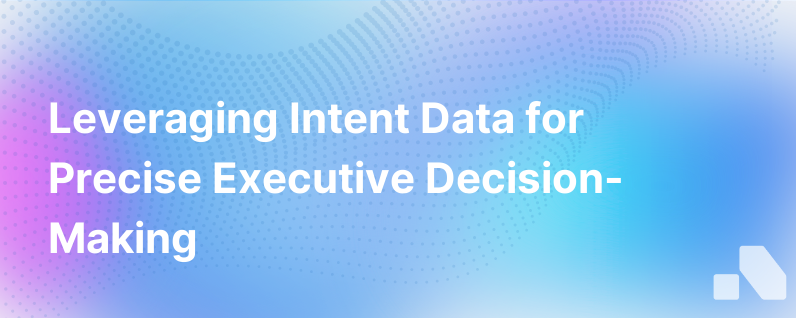
In the intricate dance of B2B sales and marketing, success often hinges on the ability to anticipate and react to a prospective buyer's next move. Hence, the growing emphasis on intent data—a term tossed around in the corridors of modern marketing with increasing fervor, and for good reason. Intent data has become the seer's crystal ball, providing insights into future customer actions, guiding businesses towards more strategic engagements, and forecasting burgeoning opportunities for growth.
But what truly matters with intent data? It’s not just about having access to it; it’s about understanding and wielding this potent form of intelligence to foster better-targeted campaigns, enhance lead qualification, and ultimately, expedite and improve the sales cycle.
Understanding Intent Data
At its core, intent data is digital breadcrumbs—signals and indicators that provide us with a glimpse into an organization’s purchasing intentions. It comes forth in varied forms, from white paper downloads to search engine queries and engagement with online content. This data, particularly when aggregated and analyzed correctly, is a windfall of information.
Intent data serves to unfold the layers of an otherwise impenetrable decision-making process, presenting a narrative of what a prospect might be considering or planning to do. There are primarily two types of intent data: first-party intent data, which is gathered directly from interactions with your own digital properties, and third-party intent data, which is sourced from external platforms and providers, offering insights based on a prospect’s behavior across the wider web.
The Importance of Intent Data
In the B2B lexicon, the realization that intent data is more than just a nicety—it’s a necessity—is settling in. The reasons are manifold:
- Enhanced Lead Scoring: Lead nurturing can seem akin to finding a needle in a haystack. Intent data elevates lead scoring processes by indicating which leads are actively in the market for solutions you offer.
- Tailored Content Marketing: By understanding the topics and solutions your prospects are researching, you can tailor your content marketing efforts accordingly.
- Precision in Targeting: Rather than casting a wide net, intent data empowers you to focus on leads that show genuine interest, thereby increasing the ROI of your marketing campaigns.
- Insightful Sales Conversations: Sales teams can enter conversations armed with knowledge about the issues and challenges that are top-of-mind for prospects.
- Competitive Advantage: Spot market trends and shifts in consumer interest to stay one step ahead of the competition.
Optimal Utilization of Intent Data
Having intent data is beneficial, but the real competitive edge lies in its application. How can businesses best utilize this data to drive meaningful results?
- Integration with Sales and Marketing Platforms: Seamless integration of intent data with your CRM and marketing automation platforms ensures that your sales and marketing teams have the latest insights at their fingertips.
- Intelligence-Led Follow-Ups: Equip your sales team with intent data insights to craft follow-up communications that resonate with where the prospect is in their buying journey.
- Predictive Analytics: Intent data feeds into predictive models, allowing algorithms to forecast future behaviors and preferences.
- Content Strategy Refinement: Analyze intent data to understand content consumption patterns and refine your editorial calendar and content creation efforts.
Real-World Application of Intent Data
Let’s talk about real-world implications where intent data changes the game:
Imagine you're an account manager for a cloud storage company. You notice a spike in research around "data security" from a prospect who's previously shown interest in your product. This is a signal, an opening. By harnessing intent data, you can proactively reach out with case studies, whitepapers, or even a free security assessment service, thereby demonstrating value and accelerating the sales process.
Challenges with Intent Data
Of course, with great data comes great responsibility. Navigating the challenges of intent data management is crucial:
- Data Quality: Ensuring you have high-quality, accurate intent data is critical. Poor data can lead to misguided strategies.
- Privacy and Compliance: Adhering to GDPR, CCPA, and other privacy regulations is non-negotiable when leveraging third-party intent data.
- Data Silos: Avoid data being trapped in silos by implementing platforms and strategies that encourage data sharing across departments.
Conclusion
In the realm of B2B marketing and sales, understanding and utilizing intent data is no longer optional—it's foundational to staying competitive in a landscape that's constantly shifting. The companies that will rise to the forefront are those bold enough to embrace this data, integrate it into their processes, and leverage its insights for strategic engagements.
Intent data is the lifeblood of informed decision-making. Whether optimizing a campaign, personalizing a pitch, or shaping a content strategy, intent data paves the way for interactions that are timely, relevant, and, most importantly, effective.
As we acknowledge the complexity of this digital puzzle, remember that platforms like Aomni help to seamlessly integrate and activate intent data across your sales and marketing efforts. With real-time account research, competitive insights, and personalized sales content at your beck and call, Aomni becomes the cornerstone of your data-driven strategy, underscoring what truly matters with intent data.